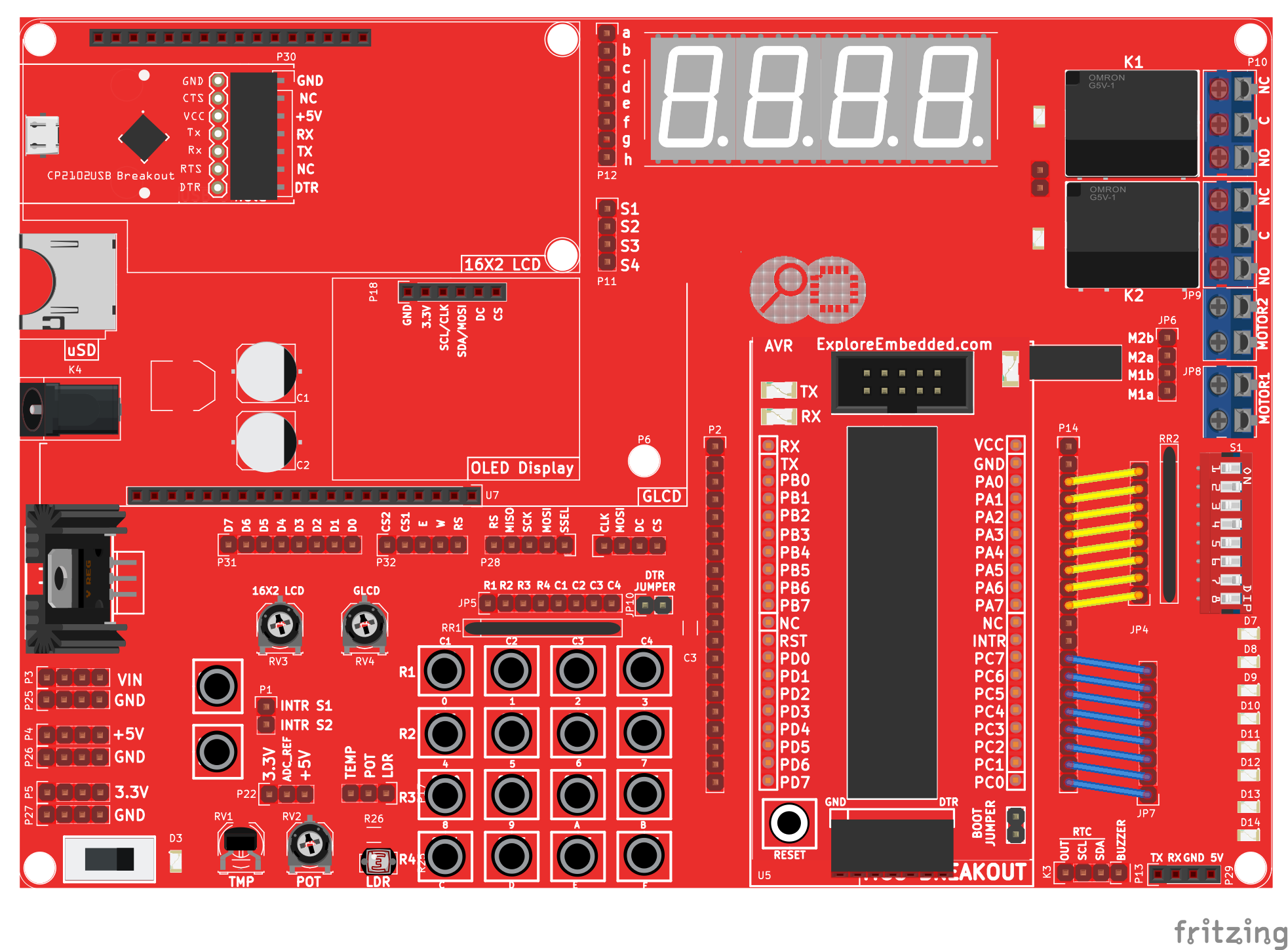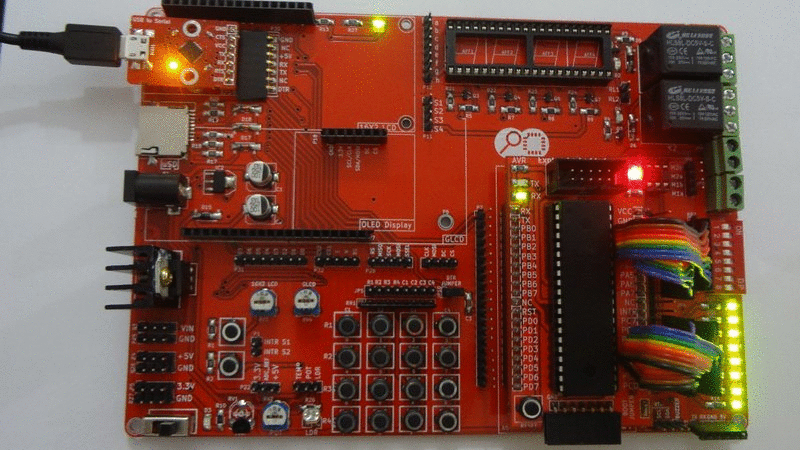Difference between revisions of "Switch and a LED with AVR"
Raghavendra (Talk | contribs) |
|||
| (11 intermediate revisions by 3 users not shown) | |||
| Line 1: | Line 1: | ||
| − | + | ||
| − | + | ||
[[Category:AVR Tutorials]] | [[Category:AVR Tutorials]] | ||
| + | |||
| + | After blinking the leds, its time to control these leds depending on external inputs. In this tutorial we will interface a DIP switch to one of the Port's and display its status on LED's connected to other port. | ||
| + | |||
| + | =Register Configuration = | ||
| + | Please refer the below tutorial for basics of GPIO register configuration. | ||
<html> | <html> | ||
| − | < | + | <ul> |
| − | < | + | <a href="https://www.exploreembedded.com/wiki/2._AVR_I/O_Register_Configuration">AVR I/O Register Configuration |
| − | + | </a> | |
| − | + | </ul> | |
| − | < | + | |
</html> | </html> | ||
| − | |||
| + | =Code= | ||
| + | Below points needs to be considered for this example. | ||
| + | * Include the io.h file as it has the definitions for all the PORT registers. | ||
| + | * Configure PORTA as inputs to read the switch status. | ||
| + | * Configure the PORTC as Output to display the switch stauts on Leds. | ||
| + | * Continuously read the switch status and display it on Leds. | ||
| + | <html> | ||
| + | <script src="https://gist.github.com/SaheblalBagwan/310b1582e0bec2ad28ad.js"></script> | ||
| + | </html> | ||
| − | = | + | ==LEDs and Switches Wiring diagram== |
| − | + | [[File:Switch_led_AVR.png]] | |
| − | == | + | |
| − | + | ||
| − | + | =Explore Ultra AVR Dev Kit= | |
| − | + | ||
| − | + | ||
| − | + | ||
| − | + | ||
| − | + | ||
| − | + | ||
| − | + | ||
| − | + | ||
| − | + | ||
| − | + | ||
| − | + | ||
| − | + | ||
| − | + | ||
| − | + | ||
| − | + | ||
| − | + | ||
| − | + | ||
| − | + | ||
| − | + | ||
| − | + | ||
| − | + | ||
| − | + | ||
| − | + | ||
| − | + | ||
| − | + | ||
| − | + | ||
| − | + | ||
| − | + | ||
| − | + | ||
| − | + | ||
| − | + | ||
| − | + | ||
| − | + | ||
| − | + | ||
| − | + | ||
| − | + | ||
| − | + | ||
| − | + | ||
| − | + | ||
| − | + | ||
| − | + | ||
| − | + | ||
| − | + | ||
| − | + | ||
The Explore Ultra AVR Kit comes with all the things required, not just for this experiment but for the entire series. And even if you think of migrating to PIC or Arduino, you'll have breakout boards that fit on to this, hence we believe it is a great investment for learning hands on Embedded Systems. The kit is fully open source, you may use the schematics, the design files and all of the source code and build something cool on your own. And when you do that do not forget to share with us what you've done. We would be happy to see you building something cool. | The Explore Ultra AVR Kit comes with all the things required, not just for this experiment but for the entire series. And even if you think of migrating to PIC or Arduino, you'll have breakout boards that fit on to this, hence we believe it is a great investment for learning hands on Embedded Systems. The kit is fully open source, you may use the schematics, the design files and all of the source code and build something cool on your own. And when you do that do not forget to share with us what you've done. We would be happy to see you building something cool. | ||
| − | |||
<html> | <html> | ||
<ul> | <ul> | ||
| Line 73: | Line 37: | ||
</html> | </html> | ||
| − | |||
| − | = | + | =Video Tutorial= |
| − | < | + | For those of you, who would like to watch instead of read we have made a video with all the gyan. |
| + | <br> | ||
| + | {{#ev:youtubehd|-lNAmSNV2-Q|640}} | ||
| − | + | [[File:0Switch LED AVR.gif|none]] | |
| − | + | ||
| − | + | ||
| − | + | ||
| − | + | ||
| − | + | ||
| − | + | ||
| − | |||
| + | = Downloads= | ||
| + | Download the complete project folder from the below link: | ||
| + | https://github.com/ExploreEmbedded/ATmega32_ExploreUltraAvrDevKit/archive/master.zip<br> | ||
| − | |||
| − | |||
| − | |||
| − | |||
| − | |||
| − | + | Have a opinion, suggestion , question or feedback about the article let it out here! | |
| − | + | {{DISQUS}} | |
| − | + | ||
| − | + | ||
| − | + | ||
| − | + | ||
| − | + | ||
| − | + | ||
| − | + | ||
| − | + | ||
| − | + | ||
| − | + | ||
| − | + | ||
| − | + | ||
| − | + | ||
| − | + | ||
| − | + | ||
| − | + | ||
| − | + | ||
| − | + | ||
| − | + | ||
| − | + | ||
| − | + | ||
| − | + | ||
| − | {{ | + | |
Latest revision as of 11:21, 19 April 2016
After blinking the leds, its time to control these leds depending on external inputs. In this tutorial we will interface a DIP switch to one of the Port's and display its status on LED's connected to other port.
Contents
Register Configuration
Please refer the below tutorial for basics of GPIO register configuration.
Code
Below points needs to be considered for this example.
- Include the io.h file as it has the definitions for all the PORT registers.
- Configure PORTA as inputs to read the switch status.
- Configure the PORTC as Output to display the switch stauts on Leds.
- Continuously read the switch status and display it on Leds.
LEDs and Switches Wiring diagram
Explore Ultra AVR Dev Kit
The Explore Ultra AVR Kit comes with all the things required, not just for this experiment but for the entire series. And even if you think of migrating to PIC or Arduino, you'll have breakout boards that fit on to this, hence we believe it is a great investment for learning hands on Embedded Systems. The kit is fully open source, you may use the schematics, the design files and all of the source code and build something cool on your own. And when you do that do not forget to share with us what you've done. We would be happy to see you building something cool.
- Explore Ultra AVR Dev Kit: Buy from EE Store

Video Tutorial
For those of you, who would like to watch instead of read we have made a video with all the gyan.
Downloads
Download the complete project folder from the below link:
https://github.com/ExploreEmbedded/ATmega32_ExploreUltraAvrDevKit/archive/master.zip
Have a opinion, suggestion , question or feedback about the article let it out here!


